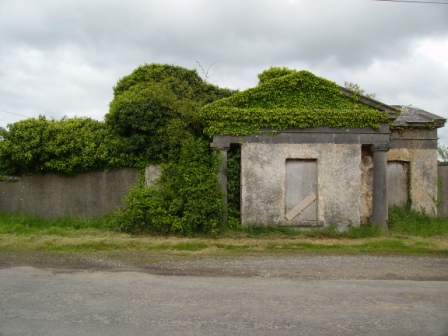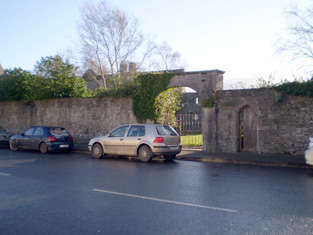Curraheen
Houses within 5km of this house
Displaying 17 houses.
Houses within 5km of Curraheen
Displaying 17 houses.
| House name | Description | |
|---|---|---|
| Farm Lodge | Marked as Farm Lodge on the first Ordnance Survey map this house on the De Vere estate was occupied by James Potter in the early 1850s when it was valued at £16. An extensive farm still exists at the site. | |
| Hollywood | Occupied by James Raymond in 1814 this house became the residence of a junior branch of the Castle Hewson family. The home of James Hewson at the time of Griffith's Valuation who held the property valued at £17+ from Henry Fitzgerald. |

|
| Ballinvira | Ballinvira was occupied by Thomas Fitzgerald in 1814 and by Gerald Browne Fitzgerald in 1837. The residence of William Power in the mid 19th century, held from Henry Fitzgerald and valued at £12. | |
| Cloghanarold | This house was the residence of J. Fitzgerald Massey in 1837 and of Hugh H. Massy in the mid 19th century. The house was valued at £18 and held from John Pigott. |

|
| Stoneville | Originally a hunting lodge of the Southwell family, this house was the home of the Massy family for two centuries. In 1786 Wilson refers to it as the seat of Hugh Massey. A new front was added in 1802 by Hugh Massy. The buildings were valued at £12 in the mid 19th century and the property was located on the Southwell estate. It is still extant. |

|
| Altavilla | Bence Jones writes that this house was built by the Bateman family in the mid 18th century to the design of Francis Bindon. In 1786 Wlson refers to it as the seat of Jon Bateman. The Ordnance Survey Name Book records that Altaville House was a rectangular building of four storeys built in 1749 by Mr Bateman and that it was then [circa 1840] undergoing repairs by Peter Griffin of Corgrieff. At the time of Griffith's Valuation it was inhabited by Peter Griffin who had carding mills and offices closeby. He held the property from William Dickson. It is still extant. |

|
| Ballinvirick | The residence of the Royse family, held in fee by Thomas Royse at the time of Griffith's Valuation and valued at £15. Earlier in the 1830s Lewis writes of the great improvements which were in progress at Ballinvirick, Thomas Royse proprietor. In 1906 the house was occupied by Frances and Isabella Royse. Sold by the Royse family in 1919, it became a dowager house for Castle Hewson in the 1920s. The house has had a number of different owners in the 20th centuries and is still a family home. It is open to the public for two months of the year, see www.ballinvirick.ie/ |

|
| Nantinan House | Bence Jones writes that this was a mid 19th century house of the villa type. The original Nantenan was the residence of Major Wilson in 1814. In 1786 Wilson refers to it as the seat of Mr. Royse. It was renovated by Thomas H. Royse in the 1830s. The Ordnance Survey Name Book [circa 1840] states that the house was built about 100 years previously and that the family arms were cut over the hall door. Lewis writes of ''the very interesting improvements'' which ''have been made at great expense'' by T. H. Royse. This Royse residence was valued at £30 at the time of Griffith's Valuation and was held by Thomas Royse in fee. Advertised for sale in 1853 the house and 145 acres were purchased by John White for £3,800. He demolished the old house and built a new one in the late 1850s, which was still in the possession of the White family in the 20th century. In 1906 this house was valued at £48. In 1944 the author Dorothea Conyers is recorded as the owner (ITA). |

|
| Ballywilliam | Seat of the Maunsell family, Ballywilliam was the residence of T.M. Maunsell in 1837 and of George M. Maunsell at the time of Griffith's Valuation when the buildings were valued at £37. In 1906 the value of the house had increased to £39 and it was occupied by Daniel M. Maunsell. A mantelpiece from Ballywilliam is now in the library at Glin Castle. |

|
| Castle Matrix | In 1837 Lewis writes that the flour mill at Castle Matrix ''has been fitted up by the proprietor J. Southwell Brown esq in the most complete manner'' and that the Elizabethan square castle was being repaired. The Ordnance Survey Field Name Book records Castlematrix as a large 2 storey house ''with a new castle 6 stories high adjoining''. John S. Brown held Castle Matrix from Lord Southwell. In the mid 19th century the buildings including the flour mills were valued at £90. In the 1853 sale rental which includes a lithograph, the castle is described as having been repaired and added to "regardless of expense. There are 9 bedrooms in the Castle, besides dressing closets, bathrooms, water closets, a large dining room, drawing room and library with extensive suites of servants' apartments, and the entire fitted up in elegant and substanial style". Castle Matrix was the headquarters of the International Institute of Military History and of the Heraldy Society of Ireland until 1991. |

|
| Beechmount | Originally known as Mount Morgell and the home of the Morgell family in the 18th century. The residence of the Lloyd family in the 19th century, held in fee and valued at £32 in the 1850s. Seat of Gen.F.Lloyd in 1894. Recorded as the property of Major Langford in 1944 (ITA). Now a stud and racing stable run by the McNamara family. |

|
| Rathkeale Abbey | The residence of J. Hewson in 1837 and previously of the representatives of George Lake [Leake] esq. By the time of Griffith's Valuation the Abbey was in the possession of Daniel Griffin who held it from the representatives of William Lake [Leake]. It was valued at £30. Referred to in 1942 as "a substanial well kept mansion" the property of Major Waller. |

|
| Mount Southwell House | Situated near the town of Rathkeale this house was the residence of Francis Brown in 1837 and was still in his possession in the early 1850s but leased to Edward John Collins. It was valued at £24. This house passed to the Hill family of Graig through marriage. | |
| Cappagh | Eyre Lloyd of Wales and William Hammond of Dublin were proprietors of this townland circa 1840. At that time Robert Peppard lived at Cappagh House which is described as an irregular two storied house, part of it built 120 years previously with later additions. Robert Peppard was still resident at the time of Griffith's Valuation when the house was valued at £14+. Robert Peppard was married to Anne Brown of nearby Mount Brown. Whelan writes that the Peppards had lived at Cappagh from the early 18th century. The last family member to live at Cappagh died in 1938. The house has had a number of owners in the 20th century and the interior was badly burnt by fire in 1983 but has since been restored. |

|
| Ballylin | Michael Smith was living at Ballylin, Rathkeale, in 1814 and R. Smith in 1837. | |
| Smithfield | Originally a Aylmer residence, later leased by the Smith family. The house was occupied by Richard Smith in 1814 and by R. Smith in 1837, later in the possession of the Fergusons. A 3 storey hand drawn house is depicted on the sale rental map of the Aylmer estate. Smithfield House is now the centre of a working farm run by the Lowe family and offers Bed and Breakfast accommodation. |

|
| Rockfield Tower | At the time of Griffith's Valuation held by Tobias Delmege from Lord Southwell and valued at £9. This house is still in use as a residence. |

|

